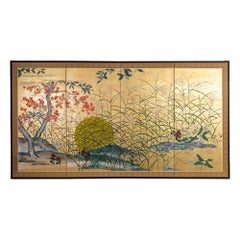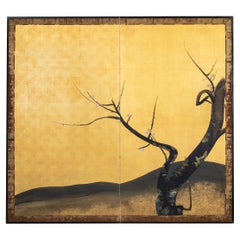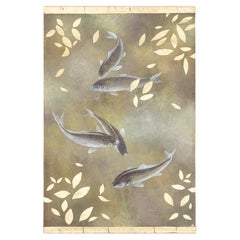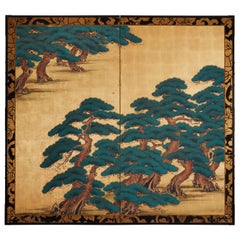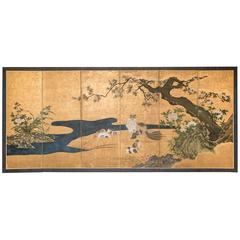Gold Leaf Paintings and Screens
to
8
121
40
221
10
2
1
60
101
60
12
15
10
5
2
1
2
2
3
1
1
6,950
785
748
724
544
213
204
189
14
14
233
227
231
9
2
1
1
1
Material: Gold Leaf
Japanese Four Panel Screen: Autumn Flowers and Moon on Gold
Located in Hudson, NY
Mineral pigments on gold leaf.
Category
Early 20th Century Japanese Gold Leaf Paintings and Screens
Materials
Gold Leaf
Japanese Two Panel Screen Winter Flowering Plum on Gold Leaf
Located in Hudson, NY
Mineral pigment on gold leaf.
Category
19th Century Japanese Antique Gold Leaf Paintings and Screens
Materials
Gold Leaf
Japanese Six Panel Screen: Rolling Country Landscape
Located in Hudson, NY
A mid-sized six panel screen. Edo period (c. 1800) painting of a landscape features a temple on the mountain top, a river with fishermen emerging from gold...
Category
Early 19th Century Japanese Edo Antique Gold Leaf Paintings and Screens
Materials
Gold Leaf
Painted canvas representing carp. Contemporary work.
Located in Saint-Ouen, FR
Painted canvas, or decorative panel, representing carp.
Contemporary French work.
Dimensions: H 120 x W 100 cm
Reference: LS6028675A
Raw linen canvas hand painted with natural pi...
Category
20th Century French Gold Leaf Paintings and Screens
Materials
Copper, Gold Leaf
Japanese Two Panel Screen: Pine on Heavy Gold
Located in Hudson, NY
Kano School painting in mineral pigments on mulberry paper with heavy gold leaf and a silk brocade border made of antique monk's robes.
Category
Late 19th Century Japanese Antique Gold Leaf Paintings and Screens
Materials
Gold Leaf
Japanese Six-Panel Screen "Mother and Her Kittens"
Located in Hudson, NY
Japanese six-panel screen: Mother and her kittens under flowering cherry tree.
Kano School painting, mineral pigments on gold, with beautiful early bronze mounts.
Category
Late 18th Century Japanese Antique Gold Leaf Paintings and Screens
Materials
Gold Leaf
Antique obi textile art " Pine forest ~ Longivety ~ " by ikasu Green , Japan
By Kimono ikasu
Located in Setagaya City, JP
<< Story behind the work >>
Obi fabric I used for this artwork is taken from three different over 100-years-old antique sashes, and is framed in wood taken from antique chest-of-dra...
Category
Early 20th Century Japanese Japonisme Gold Leaf Paintings and Screens
Materials
Gold Leaf
Pair of Japanese Edo Period Six-Panel Screen, "100 Boys at Play"
Located in Austin, TX
An absolutely charming pair of Japanese Tosa School six-panel folding screens painted with the "One Hundred Boys at Play" motif, featuring a multitude...
Category
Early 19th Century Japanese Edo Antique Gold Leaf Paintings and Screens
Materials
Gold Leaf
Six-panel gold leaf screen
Located in Brescia, IT
Large Japanese six-panel screen, ink, color, gold, and gold leaf on paper, depicting three scenes from Genji monogatari (The Tale of Genji), the vignettes punctuated by raised golden...
Category
Early 19th Century Japanese Edo Antique Gold Leaf Paintings and Screens
Materials
Gold Leaf
Early 19th Century Japanese Six-Panel Screen, Tropical Garden
Located in Hudson, NY
With a banana leaf palm on the left, at water's edge with geese. Perhaps a scene from the southern islands. Mineral pigments on mulberry paper with gold leaf and a silk brocade border.
Category
Early 19th Century Japanese Antique Gold Leaf Paintings and Screens
Materials
Gold Leaf
Late 19th century (Meiji period) painting depicting tiger
Located in Fukuoka, JP
Antique Tiger Painting on Paper – Meiji Period
A striking depiction of a tiger, painted on paper and signed by the artist. This work was originally part of a Japanese byobu folding ...
Category
Late 19th Century Japanese Meiji Antique Gold Leaf Paintings and Screens
Materials
Gold Leaf
Pair of Japanese Two Panel Screens Edo Period Vignettes
Located in Rio Vista, CA
Impressive pair of Japanese two-panel byobu screens featuring late 18th-century edo period applied vignettes, poems, and paintings in various formats over a dramatic gold leaf square...
Category
18th Century Japanese Edo Antique Gold Leaf Paintings and Screens
Materials
Gold Leaf
Antique obi textile art " View from the Window ~ Shochikubai ~ " by ikasu, Japan
By Kimono ikasu
Located in Setagaya City, JP
This work is a glorious nod to buddhist temples circle windows, with beautiful Japanese garden scape seen outside. Golden leaf on the border of a frame is an expression of light goin...
Category
1910s Japanese Japonisme Vintage Gold Leaf Paintings and Screens
Materials
Gold Leaf
Japanese Two Panel Screen: Winter Landscape Under Moonlight
Located in Hudson, NY
A full moon illuminating an ancient gnarled plum tree laden with snow covered blossoms. Mineral pigments on gold leaf with a silk brocade border and black lacquer trim with beautiful...
Category
Mid-19th Century Japanese Antique Gold Leaf Paintings and Screens
Materials
Bronze, Gold Leaf
Japanese Six Panel Screen: Pine in Snow on Heavy Gold Leaf
Located in Hudson, NY
Maruyama Okyo School painting in mineral pigments on heavy gold leaf with a silk brocade border.
Category
Early 19th Century Japanese Antique Gold Leaf Paintings and Screens
Materials
Gold Leaf
Japanese Two-Panel Screen Peony and Cherry
Located in Hudson, NY
Japanese two-panel screen: Peony and Cherry, Edo period (circa 1800) painting, formerly fusuma (Japanese sliding doors), executed in the Kano school style, featuring a cherry tree in...
Category
Early 1800s Japanese Edo Antique Gold Leaf Paintings and Screens
Materials
Gold Leaf
Pair of Japanese Taisho Period Screens Paragons of Filial Piety
Located in Rio Vista, CA
Impressive pair of Japanese screens from the Taisho period meiji. Each six-panel screen depicts an image from the 24 paragons of filial piety ...
Category
20th Century Japanese Taisho Gold Leaf Paintings and Screens
Materials
Brass, Gold Leaf
Summer Flowers Eight-Panel Botanical Screen
Located in Fukuoka, JP
Summer Flowers Eight-Panel Botanical Screen
Period: Late Edo
Size: 352x117 cm (138x46 inches)
SKU: PTA42
Immerse yourself in the splendor of late Ed...
Category
18th Century Japanese Edo Antique Gold Leaf Paintings and Screens
Materials
Gold Leaf
Vintage kimono textile art "View from the Window ~Maple&Plum~" by ikasu, Japan
By Kimono ikasu
Located in Setagaya City, JP
This work is a glorious nod to buddhist temples circle windows, with beautiful Japanese garden scape seen outside. Golden leaf on the border of a frame is an expression of light goin...
Category
1930s Japanese Japonisme Vintage Gold Leaf Paintings and Screens
Materials
Gold Leaf
Japanese Two Panel Screen Pine and Red Sun on Gold
Located in Hudson, NY
Mineral pigments on gold leaf. Signature and seal read: Anei H-eishin Boshun ga, dated: late spring 1766 with a dedication to Okyo (Maruyama).
Category
Mid-18th Century Japanese Antique Gold Leaf Paintings and Screens
Materials
Gold Leaf
Japanese Six Panel Screen: Rimpa School Painting of Winter to Spring
Located in Hudson, NY
With exotic birds including a family of quail. Mineral pigments on mulberry paper with gold dust and a silk brocade border.
Category
Early 19th Century Japanese Antique Gold Leaf Paintings and Screens
Materials
Gold Leaf
Japanese Six Panel Screen: Snow Scene
Located in Hudson, NY
Kano school painting of a pheasant in a snowy pine. Artist signature reads: Hokkyo Shunyo. Mineral pigments on gold leaf with silk brocade border.
Category
Early 19th Century Japanese Antique Gold Leaf Paintings and Screens
Materials
Gold Leaf
Japanese Six Panel Screen: Waka Poems on Basketry Design
Located in Hudson, NY
Ribbons of 17th century calligraphy poems are mounted on an 18th century screen with a woven bamboo motif. These poems are aristocratic Waka poem...
Category
17th Century Antique Gold Leaf Paintings and Screens
Materials
Gold, Bronze, Gold Leaf
Japanese Two Panel Screen, Chrysanthemums
Located in Hudson, NY
Beautiful white chrysanthemums are emphasized by heavy gold on a soft floral landscape, while gold clouds create a striking and dream-like floral scene. Gold leaf and gofun with min...
Category
Early 18th Century Japanese Antique Gold Leaf Paintings and Screens
Materials
Gold, Gold Leaf
Vintage kimono textile art "Marble Story ~ Healing ~" by ikasu Grey, Japan
By Kimono ikasu
Located in Setagaya City, JP
This work uses a vintage kimono fabric with marble pattern, that makes it look like a real piece of marble.
The line in the middle symbolizes “kintsugi” - concept of wabi-sabi, which values imperfection, impermanence, and the beauty of aging.
It is elegantly framed with paulownia wood originally used for kimono chest-of-drawers, and is filled with storytelling and sense of luxury.
I used pieces of kimono that could no longer be used as clothing and kiritansu chest-of-drawers that would normally be discarded to create the ultimate upcycled piece.
<< Explanation and meaning of pattern and colors >>
Kintsugi (金継ぎ), which translates to "golden joinery" or "golden repair," is a traditional Japanese art form of repairing broken pottery with lacquer mixed with powdered gold, silver, or platinum. I used this tecnique here to "repair" antique kimono by transforming it into art work. Beyond its literal meaning of mending broken ceramics, kintsugi carries profound philosophical and cultural significance in Japanese tradition:
・Embracing Imperfection: Kintsugi celebrates imperfection and impermanence. Rather than disguising or concealing flaws, it highlights them, treating the breakage as part of the object's history. This philosophy encourages acceptance of imperfection as an essential aspect of life, beauty, and human experience.
・Wabi-Sabi Aesthetic: Kintsugi embodies the principles of wabi-sabi, an aesthetic worldview centered on the acceptance of transience and imperfection. Wabi-sabi values simplicity, authenticity, and the beauty of things that are imperfect, impermanent, and incomplete. Kintsugi exemplifies these principles by turning what might be considered flaws into features that enhance the object's beauty and character.
・Resilience and Transformation: The act of repairing broken things with precious metals symbolizes resilience and transformation. Instead of discarding or replacing the broken object, kintsugi honors its history and transforms it into something new and valuable. This reflects broader philosophical themes of overcoming adversity, finding beauty in imperfection, and embracing change.
・Honoring the Past: Kintsugi preserves and honors the history of the object. Rather than erasing or ignoring its past, it acknowledges and celebrates it. This aspect of kintsugi can be seen as a metaphor for honoring our own personal histories, including the challenges and setbacks we have faced, and recognizing how they have shaped us into who we are today.
・Spiritual and Philosophical Symbolism: Kintsugi has spiritual and philosophical implications, reflecting concepts such as the interconnectedness of all things, the cycle of life and death, and the pursuit of harmony and balance. The process of repairing broken objects with precious metals is seen as a metaphor for spiritual growth, enlightenment, and the journey towards wholeness.
Overall, kintsugi represents not only a practical technique for repairing ceramics but also a profound philosophical and cultural perspective on life, beauty, and the human experience. It embodies values such as resilience, acceptance, and the transformative power of embracing imperfection.
<< Characteristics of the fabric >>
This vintage textile is hand-painted with a traditional painting technique where the colors are added on wet surface, which creates an effect of marble.
<< About the frame >>
Kiritansu - chest-of-drawers for kimono, is traditionally made from paulownia wood, a uniquely Japanese material closely tied to the world of kimonos.
Paulownia wood is known as the lightest wood in Japan, prased for its natural luster, resistance to moisture, and resilience against cracking. Since ancient times, it has been used in crafting furniture, chests, and musical instruments.
During the Edo period, it became customary to store cherished kimonos in paulownia chests...
Category
1960s Japanese Japonisme Vintage Gold Leaf Paintings and Screens
Materials
Gold Leaf
Late 17th-Early 18th Century Japanese Six-Panel Screen, Battle at Uji Bridge
Located in Hudson, NY
Japanese six-panel screen: Battle at Uji Bridge, the first battle at Uji was in 1180 and it marked the start of the Heike Wars. The Genji troops crossed the...
Category
Late 17th Century Japanese Edo Antique Gold Leaf Paintings and Screens
Materials
Gold Leaf
Japanese Two Panel Screen: Bamboo on Gold
Located in Hudson, NY
Bamboo grove on a knoll with stylized gold mist. Mineral pigments on gold leaf with silk brocade border.
Category
Early 19th Century Japanese Antique Gold Leaf Paintings and Screens
Materials
Gold Leaf
Japanese Six-Panel Screen Waterfall and Cherry in Audubon Landscape
Located in Hudson, NY
Japanese six-panel screen: waterfall and cherry in Audubon landscape, Edo period painting, 18th century, depicting summer and spring. A Kano Schoo...
Category
Mid-18th Century Japanese Edo Antique Gold Leaf Paintings and Screens
Materials
Gold Leaf
Late 19th century (Meiji period) painting depicting tiger
Located in Fukuoka, JP
Antique Tiger Painting on Paper – Meiji Period
A striking depiction of a tiger, painted on paper and signed by the artist. This work was originally part of a Japanese byobu folding ...
Category
Late 19th Century Japanese Meiji Antique Gold Leaf Paintings and Screens
Materials
Gold Leaf
Japanese Six Panel Screen Mother Cat and Kittens Near Rushing Stream
Located in Hudson, NY
Kano School painting, in mineral pigments and gold leaf on mulberry paper with a silk brocade border. Artist seal reads: Hokkyo Unsen.
Category
Early 19th Century Japanese Antique Gold Leaf Paintings and Screens
Materials
Gold Leaf
Two-panel screen of " Rinpa School"
Located in Brescia, IT
Floral scene of a Rimpa School garden with polychrome chrysanthemum flowers.
Two-panel screen painted in pigment on gilded rice paper of beautiful size and well preserved.
Bold color...
Category
20th Century Japanese Showa Gold Leaf Paintings and Screens
Materials
Gold Leaf
Japanese Edo Six-Panel Haboku Landscapes of Seasons
Located in Rio Vista, CA
19th century Japanese Edo period six-panel screen painted in Haboku (splashed ink) style. Depicts Four Seasons landscape scenes with two portraits of Chinese sages. One sage is trave...
Category
19th Century Japanese Edo Antique Gold Leaf Paintings and Screens
Materials
Gold Leaf
Japanese Two Panel Screen Nara Deer in Gentle Yoshino Landscape
Located in Hudson, NY
Japanese two panel screen: Nara Deer in Gentle Yoshino Landscape. Yoshino is in the Nara Prefecture, an area famous for these small and tame deer native to J...
Category
Early 1900s Japanese Meiji Antique Gold Leaf Paintings and Screens
Materials
Gold Leaf, Silver Leaf
Late 19th century (Meiji period) painting depicting tiger
Located in Fukuoka, JP
Antique Tiger Painting on Paper – Meiji Period
A striking depiction of a tiger, painted on paper and signed by the artist. This work was originally part of a Japanese byobu folding ...
Category
Late 19th Century Japanese Meiji Antique Gold Leaf Paintings and Screens
Materials
Gold Leaf
Edo Period Rimpa School Golden Screen - Summer Florals
By Rimpa School
Located in Fukuoka, JP
Edo Period Golden Screen - Summer Florals
Period: Edo
Size: 285 x 92.5 cm (112.2 x 36.4 inches)
SKU: PTA141
This Edo period screen is a golden-framed window into the summer gardens...
Category
18th Century Japanese Edo Antique Gold Leaf Paintings and Screens
Materials
Gold Leaf
Painted canvas representing flowers and birds. Contemporary work.
Located in Saint-Ouen, FR
Painted canvas, or decorative panel representing flowers and birds, rectangular in shape.
Contemporary French work.
Dimensions: H x W cm
Reference: LS60201200?A
Raw linen canvas ...
Category
20th Century French Gold Leaf Paintings and Screens
Materials
Copper, Gold Leaf
Japanese Two Panel Screen: Trees in Floral Landscape
Located in Hudson, NY
Japanese Two Panel Screen: Trees in Floral Landscape, Edo period painting (mid 19th century) of pine and other trees amongst flowers, with bamboo shoots on the right panel, and white...
Category
Mid-19th Century Japanese Antique Gold Leaf Paintings and Screens
Materials
Gold Leaf
Japanese Six-Panel Screen Late Winter into Early Spring
Located in Hudson, NY
Japanese six-panel screen: Late winter into early spring, Rimpa style painting of a garden scene with doves on a bamboo fence. Flowers in bloom including ...
Category
Early 19th Century Japanese Edo Antique Gold Leaf Paintings and Screens
Materials
Gold Leaf
Japanese Four Panel Screen: Early Spring Into Summer
Located in Hudson, NY
Japanese Four Panel Screen: Early Spring Into Summer, Meiji period (1868 -1912) painting of plum in bloom with red camellias on the right and peony and thistle on the left. A clutc...
Category
Early 1900s Japanese Meiji Antique Gold Leaf Paintings and Screens
Materials
Gold Leaf
Vintage kimono textile art "Autumn branches ~ Kintsugi ~" by ikasu Brown, Japan
By Kimono ikasu
Located in Setagaya City, JP
The frame for this work is made of paulownia wood taken from antique Kiritansu - chest-of-drawers for kimono.
I use antique kiritansu that can’t be used as furniture anymore to crea...
Category
1960s Japanese Japonisme Vintage Gold Leaf Paintings and Screens
Materials
Gold Leaf
Taisho Golden Fan Screen
Located in Fukuoka, JP
Taisho Golden Fan Screen
Period: Meiji
Size: 190x171 cm
SKU: PTA111
Step into a world of elegance with our exquisite two-panel Taisho screen adorned in gold, depicting fans adorned...
Category
20th Century Japanese Taisho Gold Leaf Paintings and Screens
Materials
Gold Leaf
Japanese Two Panel Screen Late Autumn Forest, Rare Obara Paper Art Screen
Located in Hudson, NY
A masterful landscape made entirely of carefully arranged mulberry paper fibers in a Japanese art practice called Obara. Accented with gold leaf. Incredible craftsmanship and a wonderful rendering of bare trees. Made by Yamauchi Issei (b. 1929), stamped in the corner. Issei is well known throughout Japan as the leading artist in Obara Paper Art. Starting in 1948, he apprenticed with Fuji Tatsukichi, a leading proponent of the arts and crafts movement in Japan who worked to Revive many cultural traditions on the brink of extinction. Issei started exhibiting in the Nitten in 1953, won the Gold Medal in 1963, and eventually became a juror. His artwork was given as a gift to the Showa Emperor of Japan, as well as dignitaries such as General Douglas MacArthur...
Category
Mid-20th Century Japanese Showa Gold Leaf Paintings and Screens
Materials
Gold Leaf
Japanese Six Panel Screen, Snow Scene at Water’s Edge
Located in Hudson, NY
Japanese Six Panel Screen: Snow Scene at Water's Edge with Flowers and Waterfowl. Edo period painting (mid 19th century) of plum, bamboo, white camellias, cranes and mandarin ducks ...
Category
Mid-19th Century Japanese Edo Antique Gold Leaf Paintings and Screens
Materials
Gold Leaf
Japanese Two-Panel Screen, Flower Garden
Located in Hudson, NY
Rimpa School painting featuring cascading chrysanthemums as well as cockscombs, summer wild flowers, and a climbing morning glory vine. Beautifully executed, fine painting in mineral...
Category
Mid-18th Century Japanese Edo Antique Gold Leaf Paintings and Screens
Materials
Gold Leaf
Vintage kimono textile art " Seaside ~ Kintsugi ~ " by ikasu White/Blue Japan
By Kimono ikasu
Located in Setagaya City, JP
This work is inspired by the sea and the sky, uses golden leafing as a creative point, framed in paulownia wood originally used for a kimono chest-of-drawers.
In this artwork, the aim was to capture the splendor of Japanese nature, showing the sea, sky, and forests. Traditional Japanese culture, represented by the kimono, and wood, an integral element of Japanese craftsmanship, were used to bring this vision to life.
I used two pieces of kimono that could no longer be used as clothing and bark that would normally be discarded to create the ultimate upcycled piece.
The marriage of Japanese natural materials - silk, paulownia (frame), and pine (branch slices for the center decoration) - and Japanese natural patterns - blue ocean waves and clouds - expresses the magnificent beauty of Japanese nature from various angles.
The central golden leaf decoration stands out as a distinctive feature of this work. The piece uses the concept of "kintsugi" - it "unites" the pieces of antique kimono back together with golden leaf to give it a second wind as art work.
<< Period / Story >>
The kimono used in this piece was originally crafted during the late Showa period (1960-80ies).
<< Explanation and meaning of pattern and colors >>
The kimonos on this canvas have been creatively repurposed into interior artwork. The one on the left represents ocean wave pattern.
Seigaiha waves is regarded as a pattern of good fortune, embodying wishes for eternal happiness and a tranquil life for future generations.
The fabric on the right is embellished with cloud patterns woven in various techniques. Clouds, with their ever-shifting shapes and colors, have long intrigued people as signs of big events or omens.
<< Characteristics of the fabric >>
The kimono used for a part on the left has a lustrous, ivory-colored ground that serves as a backdrop for the vibrant ocean wave pattern expressed through the ground pattern.
On the right fabric, the cloud pattern is beautifully rendered by dyeing both the plain fabric and delicate patterns. This is achieved through the so-called "Yose-komon" technique, where each cloud is adorned with small patterns such as hail, sharks skin pattern, and other intricate details.
Edo komon, created using a refined and advanced dyeing technique that appears as a solid color from a distance, originated during the Edo period (1603-1868) and remains highly popular as formal kimono attire to this day.
<< About the frame >>
Kiritansu - chest-of-drawers for kimono, is traditionally made from paulownia wood, a uniquely Japanese material closely tied to the world of kimonos.
Paulownia wood is known as the lightest wood in Japan, prased for its natural luster, resistance to moisture, and resilience against cracking. Since ancient times, it has been used in crafting furniture, chests, and musical instruments.
During the Edo period, it became customary to store cherished kimonos in paulownia chests...
Category
Late 20th Century Japanese Japonisme Gold Leaf Paintings and Screens
Materials
Gold Leaf
Painted canvas representing animals on an exotic background. Contemporary.
Located in Saint-Ouen, FR
Painted canvas representing a monkey, two birds and a parrot against an exotic forest background.
Work of contemporary French artists.
Dimensions: H 220 x W 120 cm
Reference: LS6...
Category
20th Century French Gold Leaf Paintings and Screens
Materials
Gold Leaf
Painted canvas. Panther on a golden background. Contemporary work
Located in Saint-Ouen, FR
Painted linen canvas representing a panther on a golden floral background. Contemporary French work.
Dimensions: H 220 x W 120 cm
Reference: LS60291080A
Raw linen canvas hand pain...
Category
20th Century French Gold Leaf Paintings and Screens
Materials
Copper, Gold Leaf
Painted canvas representing animals on an exotic background. Contemporary.
Located in Saint-Ouen, FR
Painted canvas representing animals on an exotic forest background.
Work of contemporary French artists.
Dimensions: H 220 x W 120 cm
Reference: LS61281089I
We have another canv...
Category
20th Century French Gold Leaf Paintings and Screens
Materials
Gold Leaf
Painted canvas representing a marmoset on a floral background. Contemporary.
Located in Saint-Ouen, FR
Painted canvas representing a marmoset in a floral decoration.
Work of contemporary French artists.
Dimensions: H 160 x W 100 cm
Reference: LS6132675Y
We have another canvas all...
Category
20th Century French Gold Leaf Paintings and Screens
Materials
Gold Leaf
Japanese Two-Panel Screen, Floral Garden on Gold
Located in Hudson, NY
Peonies, marigolds and pinks next to a garden stone with soft mountain peaks in the background. Late Edo (1603 - 1868) period painting in mineral pigmen...
Category
Early 19th Century Japanese Edo Antique Gold Leaf Paintings and Screens
Materials
Gold Leaf
Tibetan Thangka of Amitabha Buddha Hand Painted Gilded
Located in Somis, CA
One of our finest hand painted Tibetan Thangkas from Nepal. This extraordinary Thangka depicts 108 Buddhas with consorts in celestial court witnessing Amitabha's achievement of nirva...
Category
2010s Nepalese Gold Leaf Paintings and Screens
Materials
Gold Leaf
Painted canvas representing birds in a country setting. Contemporary.
Located in Saint-Ouen, FR
Painted canvas representing birds in orange tones on a rural evening background.
Work of contemporary French artists.
Dimensions: H 160 x W 100 cm
Reference: LS6133675K
Raw linen...
Category
20th Century French Gold Leaf Paintings and Screens
Materials
Gold Leaf
Pair of Japanese Screens: Ink paintings of peacocks on gold leaf by Imao Keinen
By Imao Keinen
Located in Prahran, Victoria
A pair of screens by Imao Keinen featuring peacocks painted in ink on gold leaf. Lacquered wood frame, brocade border, incised copper hardware.
Dimensions: H 175cm x W 352cm
Biogr...
Category
Late 19th Century Japanese Meiji Antique Gold Leaf Paintings and Screens
Materials
Gold Leaf
Japanese Two Panel Screen: Horses in Stable
Located in Hudson, NY
A pair of captivating black and white horses, believed to define hard work and power in Japanese mythology, are beautifully rendered in this painting of mineral pigments on mulberry ...
Category
Early 19th Century Japanese Antique Gold Leaf Paintings and Screens
Materials
Bronze, Gold Leaf
Japanese Four Panel Screen, Golden Sun Through Turbulent Surf
Located in Hudson, NY
Golden sun viewed through red maple above turbulent waves. Mineral pigments on gold and silver ground with silk brocade border.
Category
Mid-20th Century Japanese Gold Leaf Paintings and Screens
Materials
Gold Leaf, Silver Leaf
Japanese Two Panel Screen: Simple Chrysanthemums on Gold
Located in Hudson, NY
Mineral pigments on gold leaf. Not signed, by: Baikei Hitsu.
Category
1880s Japanese Antique Gold Leaf Paintings and Screens
Materials
Gold Leaf
Early 19th Century Rimpa School Floral Screen
By Rimpa School
Located in Fukuoka, JP
Early 19th Century Rimpa School Floral Screen
Period: Early 19th Century
Dimensions: 367x171 cm (144.5x67.3 inches)
SKU: RJ118/2
This 6-panel gold-leafed screen is a splendid repre...
Category
Early 19th Century Japanese Edo Antique Gold Leaf Paintings and Screens
Materials
Gold Leaf
Japanese Six-Panel Screen Women of the Court in the Garden
Located in Hudson, NY
Japanese six-panel screen: Women of the Court in the Garden. Edo period (circa 1700) painting of an early Kano school subject matter: nobility socializing in a coutryard garden. Deta...
Category
Early 1700s Japanese Edo Antique Gold Leaf Paintings and Screens
Materials
Gold Leaf
Recently Viewed
View AllMore Ways To Browse
Huang Gang
Ikuo Hirayama
18th Century Coromandel Screen Large Chinese
Antique Erotic Miniature Paintings
Asian 4 Wall Panel Gold Birds And Flowers
Asian Painting On Silk 1980s
Autumn Grasses Japanese Six Fold Screen
Battle Of Yashima
20th Century Showa Period Garden Folding
Asian 4 Panel Floor Screens
Zhao Shao Ang
19th Century Japanese Poem Calligraphy Hanging Scroll
Yamaguchi Sekkei
